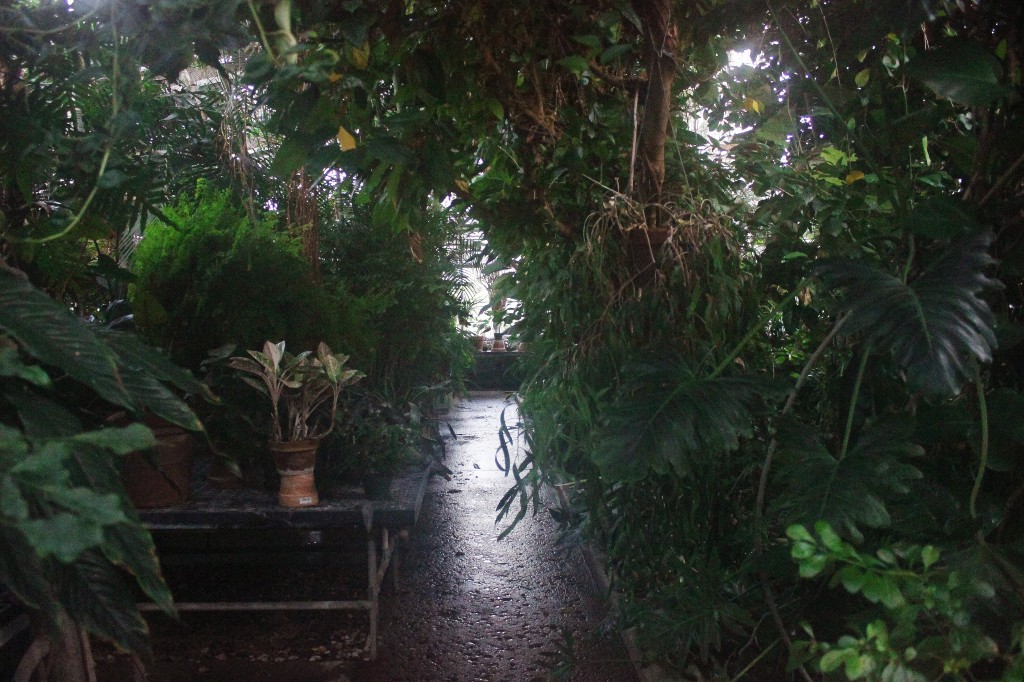“Come forth into the light of things, Let nature be your teacher,” reads the plaque just outside the doors to Binghamton University’s Teaching Greenhouse. The building, attached to Science 3, has gone relatively unexplored by most students. They’re missing out. Simultaneously relaxing and educational, the greenhouse is home to a collection of amazing specimens of varied color, size and scent.
The first greenhouse still standing on Binghamton’s campus was built in 1981, succeeding several other smaller ones, the first of which was completed in 1965. In 1996, another greenhouse was built, expanding the complex into the E.W. Heier Teaching & Research Greenhouses it is today.
If you walk straight through the double door entrance to the complex, you’ll be warmly greeted by the Warm Temperate room. Here, you’ll find plants native to climates that do not freeze, but which generally have a cooler seasonal resting period. You may also find Josh DeMarree, the greenhouse assistant, as he tends to the plants, both caring for the greenery and invoking the spirit of education for which the Teaching Greenhouse takes its name.
Making his way down one of the Warm Temperate aisles, DeMarree ducks, avoiding the large fronds of Cycads, a plant that evokes images of the Jurassic period with shady fern-like leaves that could belong in the canopy of an ancient forest.
“We have a number of Cycads,” DeMarree said. “They are an extremely old species of plant and are kind of the precursor to what you think of as Conifers today, the two being separated by millennia of development.” DeMarree said that the greenhouse’s collection of Cycads genoa outnumbers that of London’s Kew Gardens, the world’s largest collection of living plants.
Passing beneath a cashew tree, DeMarree shows off the greenhouse’s orchid collection.
“We had a number of water issues a few years ago,” DeMarree said. “I think we lost almost half of our collection due to the very salty and basic water we used to use. We’ve since been building our collection back because we lost most of our orchids.”
While students have school off for winter break, there’s still work to do in the greenhouse. A typical day consists of a few hours of watering, sweeping and maintenance work, as the plants produce an enormous amount of biomass that needs to be cleaned up and controlled. The effort that DeMarree, the volunteers and Greenhouse manager Laurie Kasperek put into working with the plants isn’t fruitless, however: There can be edible benefits that go along with the job. The greenhouse is home to cashews, key limes, bananas, figs and coffee trees, to name just a few. Last year, seven of the greenhouse’s volunteers harvested, dried and fermented all of the coffee beans from the tree over four months.
“Through that entire process, we barely brewed enough for one pot of coffee” DeMarree said, laughing. “It was hundreds of beans and hundreds of hours of work, but the volunteers and I took small sips.”
Since cactii are extremophiles — meaning they’re capable of surviving in a number of different conditions — they’re found in every room. The Desert Room, however, isn’t dominated by cactii, but by euphorbias that tower over the planting bed and reach as high as the glass panes on the greenhouse roof. Commonly confused with cacti, euphorbias are an unrelated genus of flowering plant which evolved to inhabit similarly dry and extreme conditions.
“They grow like crazy,” DeMarree said, pointing to the arm-like protrusions of the massive euphorbia. “We just pruned the top about a year ago and they’ve already grown back. In the tropical house we take the top six feet off the ceiling every six months.”
The Tropical Room is the most overgrown and shaded of the greenhouse’s sections, with some of the tallest plants almost obscuring the view of the ceiling altogether. When entering the room, there’s a noticeable temperature and humidity change.
Perhaps the most interesting specimen of the Tropical Room — and without a doubt the most bizarre — is the Titan Arum, otherwise known as the “corpse flower.” Named “Metis,” Binghamton’s corpse flower last bloomed in spring 2013, producing a six-foot flower and a stench of rotting flesh which, according to DeMarree, could attract flies and beetles from up to a mile away.
Don’t let the threat of the corpse flower’s scent scare you away; it smells like that only on the rare occasion it blooms. Normally, the greenhouse is as beautiful as it is tranquil, open to all students from 8:30 a.m. to 4 p.m., Monday through Friday. It can be a fantastic space for relaxation and learning because of its quiet atmosphere. The Warm Temperate room even features a small pond opposite the entrance, which fills the room with the soft and calming sound of running water. Some other campuses use their botanical collection to help students relax. Cornell University, for example, sets up impromptu plant displays around campus to help alleviate stress during finals week.
“Especially during the winter, this can be a great place for students to come and visit,” said Kasperek. “They can escape the snow and see a little bit of green instead of white.”
Tucked away among the science buildings, the greenhouse hosts an incredible collection of plants, with a knowledgeable and pleasant staff. Whether your passion lies in botany and biology, or you simply want to visit the greenhouse for aesthetic reasons, let nature (or the self-guided tour script available on the greenhouse’s webpage) be your guide.



